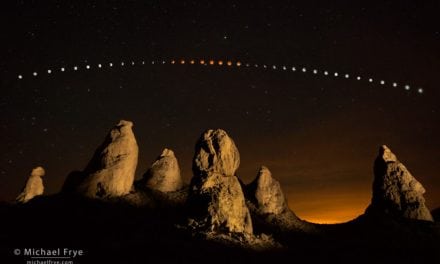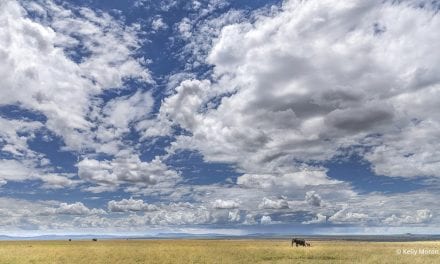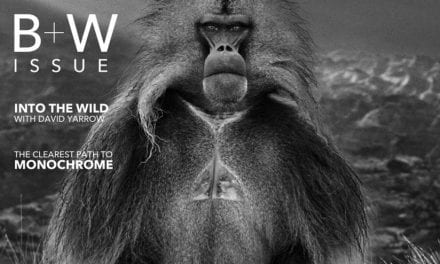Photographing bald eagles at their nest is always challenging. Over the course of a recent summer, I was privileged to observe a pair of bald eagles as they raised two chicks on a lakeshore in Adirondack Park in upstate New York.
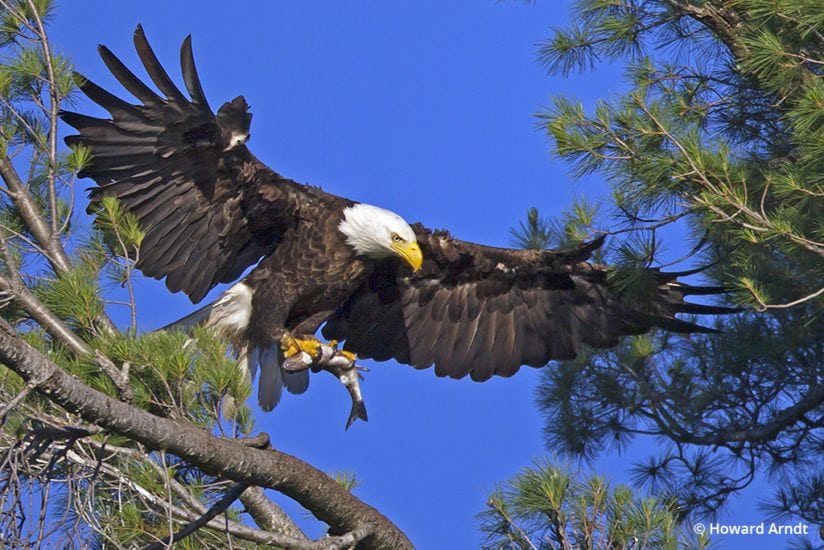
Finding Perspective When Photographing Bald Eagles
Apparently eagles, like humans, prefer high-rise waterfront views and pick their nesting tree accordingly. Since their nest, 100 feet up in an eastern white pine, was mostly visible from the water, I developed (after some experimentation) a shooting approach using a canoe. A friend made me a “legless” chair for the bottom of the canoe so I could sit in comfort and use the canoe like a kayak. This gave me an easily maneuverable and stable platform—most of the time. The biggest problem was drifting due to current or wind, countered on occasion by tying up on the opposite shore, though my view of the nest was somewhat reduced. I was typically shooting at a distance of 100 yards or more from the nest to have the best possible view of the nest as well as the eagles’ ingress and egress routes. The eagles were unperturbed by the presence of my canoe as they were accustomed to seeing kayaks, canoes and small engine power boats on the lake.
Gear & Exposure Settings
My camera set up consisted of a camera and a Canon 800mm lens mounted on a Wimberley WH-200 gimbal head supported by a Manfrotto 682B monopod. With this arrangement, the camera and lens were balanced and required little effort to hold during shooting sessions that often stretched for several hours.
Bald eagles are particularly challenging to photograph, as they are a high-contrast subject with white head and tail and dark brown body. To obtain a good photograph, the head must be properly exposed, necessitating shooting at -1 EV (exposure value) or more in order not to overexpose the head. Some underexposure of the body can be compensated for in post processing, but a blown-out head results in a picture headed for the trash bin.
A mix of camera bodies and a prime lens with and without an extender enabled me to achieve effective focal lengths of 800mm to 1456mm. This provided me the flexibility to frame photos based on their activity on the nest and nearby perches.
To capture sharp in-flight shots, I tried to make sure that my shutter speed was at least 1/1600 of a second or higher. I shot in aperture priority mode and set a depth of field to keep all of the elements of the scene at the nest in focus. The nest was over 10 feet across and an eagle’s wingspread is about 7 feet. Thus, I usually tried to shoot at about ƒ/8, which yields a depth of field of about 13 feet at 100 yards for the 800mm lens. I would adjust the ISO manually to achieve these settings for the given light situation that day.
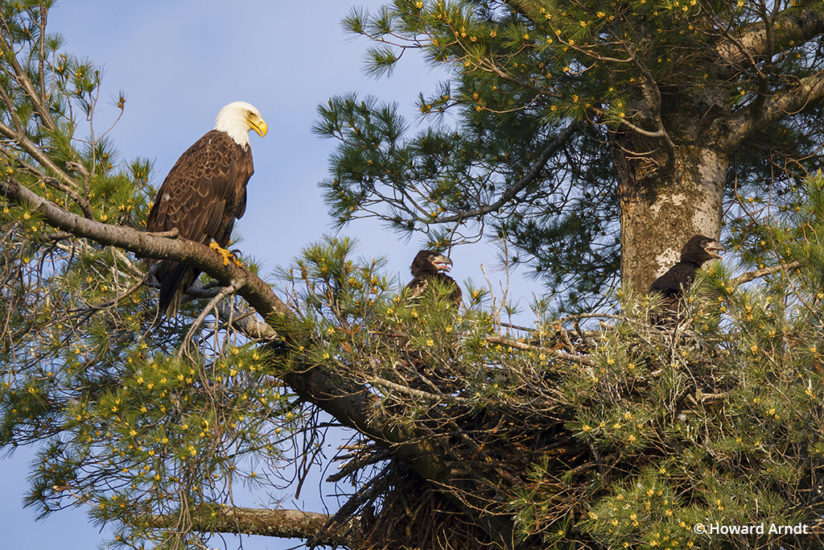
Bald Eagle Habitat & Behavior
Light on the nest was best from late afternoon until sunset. This was also when the parents would often bring in a fish to feed the chicks, providing the best photographic opportunities. Photographing wildlife requires considerable patience, but putting in the time will yield results.
If there is one thing that I learned, it was that eagles are unpredictable. I had to be on constant alert, as they could appear without warning, flying in from any direction. Some days consisted of watching an adult and the chicks just sleeping and grooming. Other times, they would bring in two or three fish within a half hour, and I would easily shoot hundreds of frames. To be a successful wildlife photographer requires both planning and perseverance, along with good equipment and mastery of its use—not to mention that you need to find the subject to start with!
I first spotted the two chicks, looking much like baby dinosaurs, peeking out of the nest in mid-May. Eagle parents are very dedicated to their offspring. When the chicks are small and vulnerable, one parent always stays in or near the nest to protect them from predators. The female spent the most of her time on guard duty while the male did most of the fishing.
It was interesting to note the different habits of the two adults as they interacted with the chicks. When the female brought a fish back to the nest, she would tear off pieces and feed the chicks, while the male would typically fly in, drop off the fish and leave it for the female to feed the young. The firstborn chick is dominant and it is fed first to ensure the survival of at least one chick.
As the chicks grew larger and stronger, the parents began to leave them alone for longer periods of time. The youngsters spent much of their time looking to the sky for their parents and screeching endlessly for food. When a parent arrived back at the nest and fed them, they would quiet down and take a nap.
In preparation for flight, the chicks would vigorously flap their wings to develop their muscles. By early July, they began hovering a few feet above the nest and then bravely rose up to 20 to 30 feet, often making very awkward crash landings back into the nest. They appeared amazed at what they discovered they could do! The dominant chick was clearly a risk-taker while its younger sibling would look on in apparent awe.
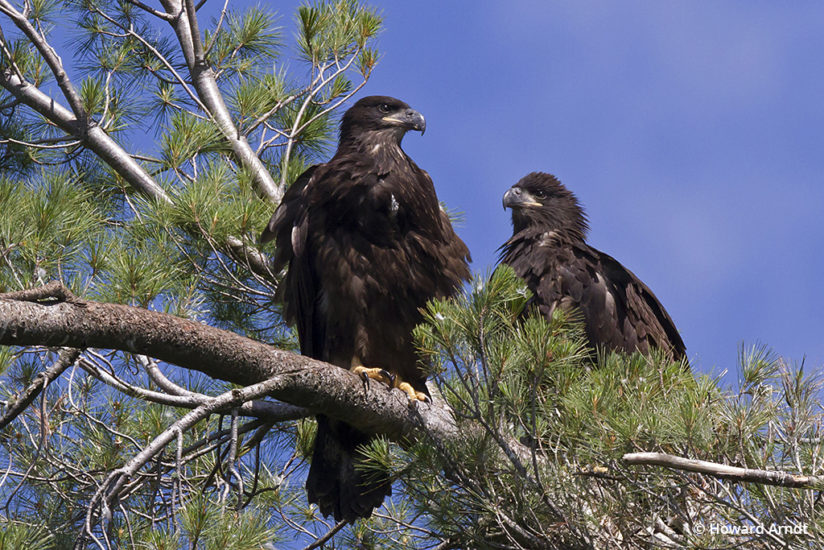
As they grew to near adult size the parents spent less and less time in close proximity to the nest, returning only to bring in fish to feed the chicks. However, the parents seemed to be always nearby as one would suddenly appear out of nowhere if there were a perceived threat. One day an osprey flew in and hovered high above the nest, and the male eagle immediately flew to the top of the highest tree near the nest to aggressively defend his territory. The osprey flew off, but the male maintained his rather precarious perch for over an hour, scanning the sky. No sooner had he moved to a lower, more substantial branch, than a 3-year-old adult bald eagle flew by and the adult male launched an attack to drive away the interloper.
Photographing Bald Eagles Leaving The Nest
In mid-July, when the chicks were 12 weeks old, they fledged from the nest. They continued to roost in the trees nearby, regularly flying from tree to tree, developing their flight skills and continuing to make awkward landings. In just a couple of weeks, they could be seen soaring and pirouetting high in the sky, showing the beauty of eagles on the wing.
While they grow very quickly during their first months of life and master flying with relative ease, bald eagles take five years to reach maturity and obtain their classic white head and tail feathers. The change in the color of their head and tail feathers is gradual, and young adults often have a mottled appearance, especially after their third year. As they move toward maturity, their beaks change from a dark brownish black to bright yellow, and their eye color goes from brownish black to yellow as well.
After the chicks fledged, the family dynamics changed. While they remained in the vicinity of the nest, the family no longer actively visited it as the nest is only used as a place for nurturing the young before they can fly. The adults continued to feed the chicks for about two months as they matured. They stopped feeding them in the nest and instead brought fish to locations on the ground. Eagle parents take an active role in teaching their young how to fish. I was fortunate to witness the female showing a youngster how to fish by hovering and swooping down to the water repeatedly in an effort to have the youngster mimic her actions.
A family squabble occurred one day when the two youngsters were sitting on the ground squawking for food. The dominant sibling flew off to a perch in a tree, and the younger sibling flew forward to take the spot just vacated. Soon thereafter, the male flew in with a fish that he gave to the younger sibling, which scurried off to the protection of some low pine tree branches to devour its meal. The dominant chick flew in screeching and attacked the male for giving away “its” fish. The male flew to the top of the tree and the dominant sibling followed, knocking him off his branch. As he flew away, the youngster took the tree top perch and proceeded to raise his head straight up, screeching in apparent anger at the male’s temerity in feeding the younger sibling first. The female sat in a nearby tree watching but chose not to get involved.
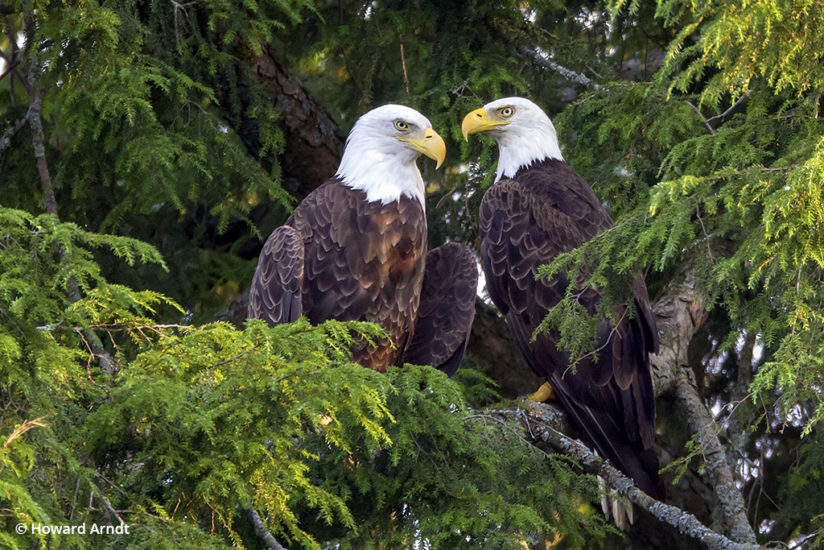
You might be surprised, as I was, to discover that eagles can swim. One day the male swooped down to catch a fish and somehow ended up in the water. Totally soaked, he looked around as if to assess the situation and swam forward doing a breaststroke with his wings for 20 to 30 yards. He then flew a short distance to a log where he shook off the water and groomed himself.
During August, the young eagles could be seen roosting in trees over a mile from the nest, usually with one of the adults nearby. In early September, all four eagles disappeared from the area. When the adults reappeared later in September, the youngsters were no longer in tow. They had apparently been sent off to find their own way in the world. Thus, my time with the Adirondack eagle family became a cherished memory.
Bald eagles were reintroduced to the Adirondack Park though a New York program in the 1970s, and several mated pairs now make their home in the park. The two adults I watched are both banded, and through their registration numbers I was able to learn their background. New York State’s Department of Environmental Conservation personnel banded the female (E74) as a chick in 2001 near Tusten, New York. The Massachusetts Division of Fisheries and Wildlife personnel banded the male (WK3) in 2002 near Conway, Massachusetts. Somehow they found each other and have made their home in the Adirondacks for at least eight years.
In a sad postscript, the next spring disaster struck when a severe windstorm broke a major branch supporting the nest. The nest was totally destroyed as it crashed to the ground and, along with it, a single chick. The short breading season in the Adirondacks precluded starting another family that year. The eagle pair continues to be seen around the lake, but a new nest, if there is one, has yet to be located.
Howard Arndt’s Wildlife Photography Gear
- Canon EOS-1D X Mark I
- Canon EOS-1D Mark IV
- Canon EOS 7D Mark II
- Canon EF 800mm f/5.6L IS USM
- Canon Extender EF 1.4x III
- Wimberley WH-200 Gimbal Head
- Manfrotto 682B Monopod
- LensCoat lens cover & RainCoat
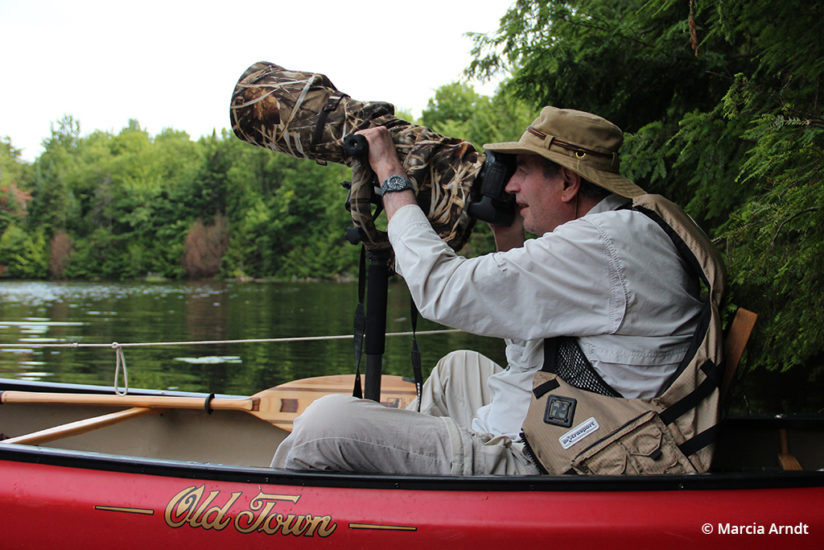
Howard Arndt is a wildlife and conservation photographer based in Amherst, New Hampshire. He has won several awards, including a photo selected as one of the Top 100 in Audubon’s 2016 Photo Contest. See more of Arndt’s work at howardarndtphoto.com.
The post Photographing Bald Eagles Of The Adirondack appeared first on Outdoor Photographer.













